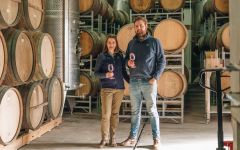David & Nadia Elpidios 2019
- Vinous



Product Details
Your Rating
Somm Note
Winemaker Notes
The blend consists of Carignan, Syrah, Pinotage, Cinsault and Grenache. Made in similar fashion than to their main Grenache in terms of long, gentle extraction, the use of 50% on average whole bunches, pressed off and matured partially in bigger format vertical foudre and old 500 L neutral French oak barrels. Matured for a year before bottling and then matured in bottle for 18 months before release.
Blend: 38% Carignan, 36% Syrah, 10% Pinotage, 9% Cinsault, 7% Grenache
Professional Ratings
-
Vinous
The 2019 Elpidios presents a beautifully defined nose of Bing cherry, boysenberry and raspberry preserve, touches of sous-bois and Provençal herbs developing with time. The palate is medium-bodied, with the Grenache firmly in the driving seat (38% of the blend), delivering touches of clove and white pepper and a persistent, caressing, fleshy finish that lingers. Excellent.
Other Vintages
2020-
Robert
Parker -
James
Suckling
- Vinous
- Decanter
-
Robert
Parker





David and Nadia Sadie met at the University of Stellenbosch when he shifted his focus to viticulture after a rugby injury sidelined him from his first love. David went on to work vintages around the world, from Marlborough to St. Emilion, before finally landing back in South Africa. He eventually took over the cellar in the Swartland where Andrea and Chris Mullineux used to make wine prior to their purchase of Roundstone Farm and restored it in 2014. His wife Nadia joined him in 2016 and it’s been a family affair ever since. Nadia oversees viticulture for their project and manages the vineyards that they lease. She employs biological farming, which is to say she avoids the use of any herbicides, plants cover crops and she’s begun experimenting with a conversion to organics. Together, they make high acid, textured wines that have helped them cement their status as some of the mostly highly regarded winemakers in the Swartland.

With hundreds of red grape varieties to choose from, winemakers have the freedom to create a virtually endless assortment of blended red wines. In many European regions, strict laws are in place determining the set of varieties that may be used, but in the New World, experimentation is permitted and encouraged resulting in a wide variety of red wine styles. Blending can be utilized to enhance balance or create complexity, lending different layers of flavors and aromas. For example, a red wine blend variety that creates a fruity and full-bodied wine would do well combined with one that is naturally high in acidity and tannins. Sometimes small amounts of a particular variety are added to boost color or aromatics. Blending can take place before or after fermentation, with the latter, more popular option giving more control to the winemaker over the final qualities of the wine.
How to Serve Red Wine
A common piece of advice is to serve red wine at “room temperature,” but this suggestion is imprecise. After all, room temperature in January is likely to be quite different than in August, even considering the possible effect of central heating and air conditioning systems. The proper temperature to aim for is 55° F to 60° F for lighter-bodied reds and 60° F to 65° F for fuller-bodied wines.
How Long Does Red Wine Last?
Once opened and re-corked, a bottle stored in a cool, dark environment (like your fridge) will stay fresh and nicely drinkable for a day or two. There are products available that can extend that period by a couple of days. As for unopened bottles, optimal storage means keeping them on their sides in a moderately humid environment at about 57° F. Red wines stored in this manner will stay good – and possibly improve – for anywhere from one year to multiple decades. Assessing how long to hold on to a bottle is a complicated science. If you are planning long-term storage of your reds, seek the advice of a wine professional.

Literally meaning "the black land," Swartland takes its name from the endangered, indigenous "renosterbos" (translating to rhino bush), which used to be plentiful enough to turn the entire landscape a dark color certain during times of year. The district, attracting some of the most adventurous and least interventionist winemakers, excels in robust and full-bodied reds as well as quality fortified wines.
